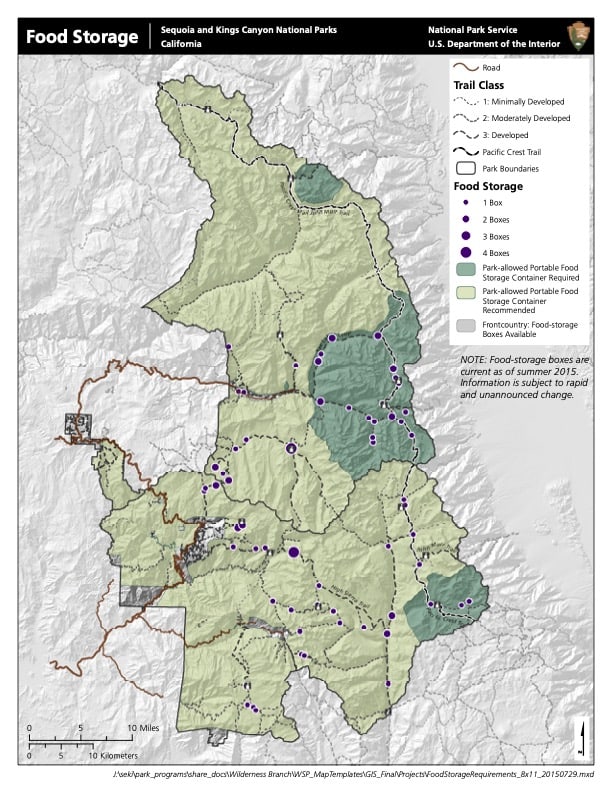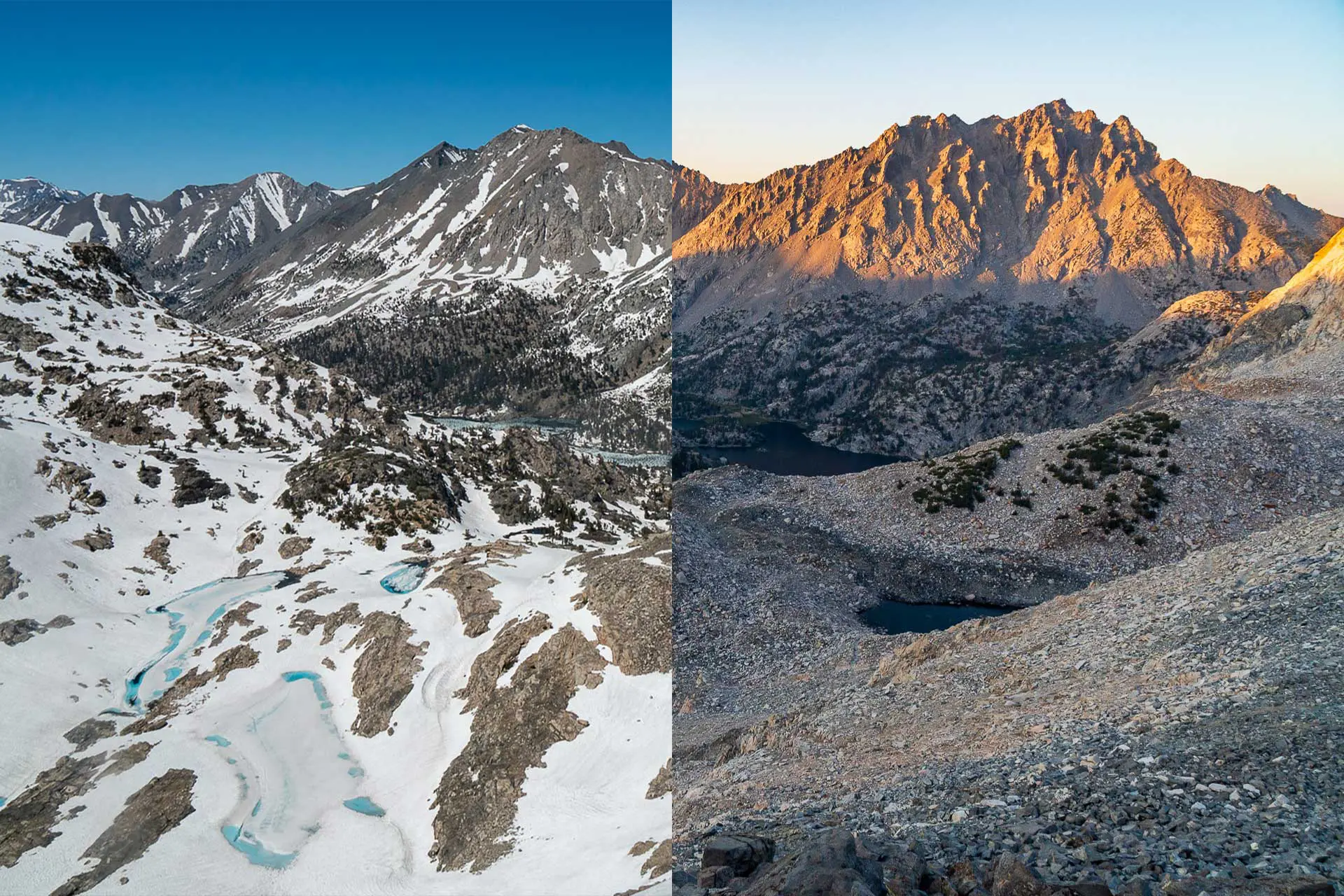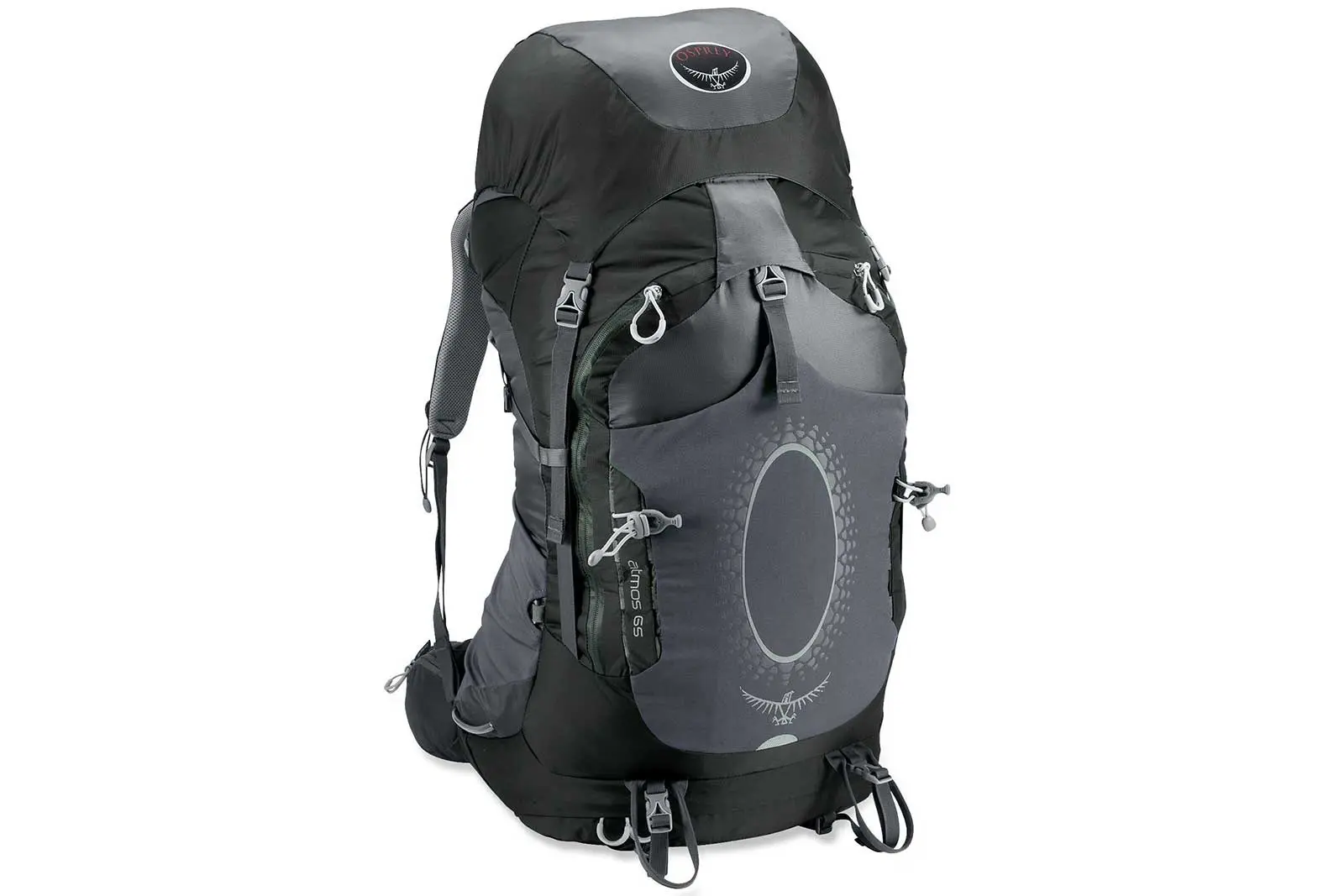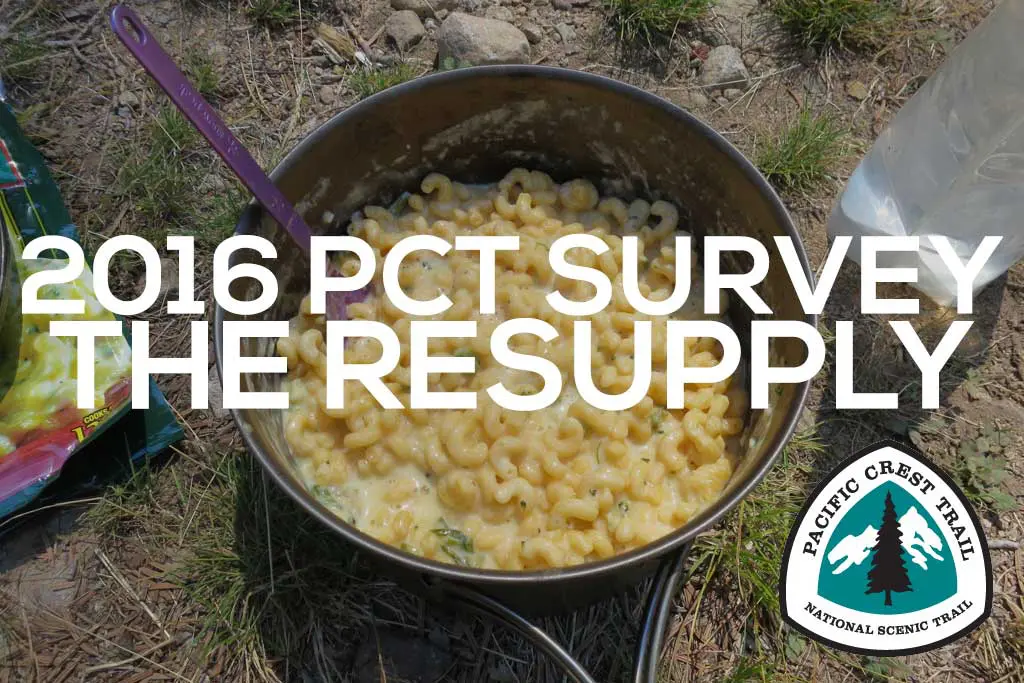How to Hike the PCT Without a Bear Canister
On a recent trip to Sequoia National Park, I noticed a paper taped to the wall at the backcountry permit office. Specifically, this piece of paper. I asked the ranger, “I was under the impression you were required to have a bear canister everywhere in Sequoia and Kings Canyon National Parks, but according to this piece of paper, you are only required to have one in these highlighted areas?”
He informed me that the paper was correct and that a bear canister was only required in the areas highlighted on the map. This got me thinking about the Pacific Crest Trail, and whether the “Kennedy Meadows to Sonora Pass” PCT rule was not entirely accurate. More on where bear canisters are required on the PCT here.
Now, before you get too excited, know this article borders on theoretical and is not intended as an invitation for Pacific Crest Trail hikers not to carry bear canisters. You should carry a bear canister; I always do in the Sierra. Bear canisters are not for you; they’re for the bears (which are often relocated or even killed if they end up getting into delicious people’s food).
That said, let’s explore what a bear canister-less thru-hike would look like.
Notes and Disclaimer
- Bear canisters are now also required in Desolation Wilderness. More on that here.
- The (usually) rectangular metal boxes found at many campgrounds and in the backcountry are officially called food storage lockers. In this article, I will refer to them as bear boxes.
- Counterbalancing (i.e., bear hanging) your food is an acceptable form of food storage in Inyo National Forest and Sequoia/Kings Canyon National Parks outside the areas requiring a bear canister (more on these specific areas here). But please note, it is very difficult to find trees adequate for a proper bear hang. Therefore, for this article, I will mostly ignore the fact (proper) bear hangs are legal in many areas.
- Stop putting your bear canisters inside bear boxes. Bear boxes are for food and items that are not inside of a bear canister. Your bear canister is bear-proof. Putting it inside of a bear box just takes space away from people who may actually need the space inside. If I need to use a bear box that’s full because of people’s bear cans, I will take them out (and so should you – just make sure they’re properly closed).
- I write this article from the point of view of a northbound PCT thru-hiker. If you’re southbound, I have faith you will have the smarts to work backward through the mass of text that’s to come.
- SEKI’s list of bear box locations contains some ambiguous language. The dropdowns along the PCT state, “CANISTERS REQUIRED, FOOD-STORAGE LOCKERS FOR PCT THRU-HIKERS.” This gives the impression that PCT thru-hikers have priority when it comes to bear boxes, but this could be outdated or incorrect (the National Park Service isn’t always the fastest when it comes to updating its websites).

South Sierra Wilderness (Inyo/Sequoia NF)
The first area with food storage restrictions northbound Pacific Crest Trail thru-hikers enter is the South Sierra Wilderness. Management of this area is split between Inyo National Forest and Sequoia National Forest. Inyo National Forest explicitly states that the only acceptable means of food storage are:
- A bear canister
- A bear box
- The counterbalance method (i.e., bear hang)
According to phone calls I’ve made to the Kern River Ranger District, there are no food storage requirements for the portion of the South Sierra Wilderness managed by Sequoia National Forest. I also cannot find it explicitly stated anywhere online that Sequoia National Forest requires specific food storage methods in the South Sierra Wilderness. If you want to reach out, their number is +1 (760) 376-3781 (at the time of publication).
The PCT first enters Inyo National Forest (still in the South Sierra Wilderness) at the confluence of Lost Creek and the South Fork Kern River (northbound FarOut mile 705). From here, north to Cow Canyon, the South Fork Kern River serves as the Inyo boundary. Anything east or north of the South Fork Kern River is part of Inyo. However, about a mile (1.6 km) after entering Inyo, PCT hikers cross the South Fork and leave Inyo for approximately 11 mi / 17.7 km (between northbound FarOut miles 706.6 and 716.5). After this stretch, the PCT remains in Inyo for 37.5 mi / 60.4 km before entering Sequoia National Park.
During these 11 mi / 17.7 km, hikers are in the South Sierra Wilderness managed by Sequoia National Forest and may legally camp without a bear canister and without hanging their food. The distance from where hikers reenter Inyo to Horseshoe Meadow via Mulky Pass is just under 30 mi / 48.3 km.
Horseshoe Meadow is one of the first places hikers (typically) opt to exit the Sierra north of Kennedy Meadows to resupply. Note that it is off-trail, so you will do some non-trail miles to reach it (and will have to climb back up to the PCT from it). There is a paved road leading up to Horseshoe Meadow, which is a popular trailhead during the summer months (when the road is open). There are multiple campgrounds at Horseshoe Meadow, along with plenty of bear boxes (where you can legally store your food while camping), and toilets.
To summarize, if you camp just south of the Inyo boundary at the South Fork Kern River and then hike 30 mi / 48.3 km the following day, you won’t have to start carrying a bear canister until Lone Pine (the closest town to Horseshoe Meadow).
Note: You can exit the PCT to Horseshoe Meadow via Trail Pass and Cottonwood Pass if you want to make it a bit further up the trail before heading down.
Sequoia-Kings Canyon Wilderness (SEKI)
Shortly after leaving Horseshoe Meadow, hikers enter the Sequoia-Kings Canyon Wilderness (part of Sequoia and Kings Canyon National Parks).
The first bear box on the PCT (northbound from Horseshoe Meadow) is at Rock Creek. The shortest way here is via Cottonwood Pass (13.5 mi / 21.7 km); if you exited Mulky Pass and want to rejoin the PCT where you left it, you’ll add 3.7 mi / 6 km to the trip – 17.2 mi / 27.7 km total. That said, this bear box falls within an area designated as requiring bear canisters (the Rock Creek Drainage), so I’m not sure that storing your food in the bear box here would exempt you from this.
If you prefer to use a bear box somewhere not within a “bear canister required” area, you’ll have to make your way to Lower Crabtree Meadow (where hikers turn off to hike up Mount Whitney). From Horseshoe Meadow to Lower Crabtree Meadow via Cottonwood Pass is 19.4 mi / 31.2 km. Again, add 3.7 mi / 6 km to the trip if rejoining the PCT at Mulkey Pass.
North of Crabtree Meadow, things again become tricky as you enter another “Park-allowed Portable Food Storage Container Required” area between Forester Pass and Pinchot Pass (northbound FarOut miles 779.5 to 807.1). That said, if you’re willing to put in another big day, you can hike just under 30 mi / 48.3 km via Forester Pass and Kearsarge Pass to Onion Valley Trailhead, where there are bear boxes you can use (or you can hitchhike to town). There is a paved road leading to Onion Valley. This is where hikers go down to Independence (the closest town) to Bishop via Highway 395 (a much larger town with far more amenities).
Leaving Onion Valley, our thought experiment breaks as no backcountry bear boxes are available north of the “bear canister required” area you’ll pass through between Kearsarge Pass and Pinchot Pass. So, to be safe, I would say that Independence (or Bishop) via Onion Valley is the latest you should pick up your bear canister (assuming you’ve followed the instructions here).
That said, if you make the 25+ mi / 40+ km trip over Kearsarge Pass, Glen Pass, and Pinchot Pass, you’re out of the “bear canister required” zone and can technically (legally) hang your food. However, you’ll (likely) need to travel an additional 3+ mi / 5+ km north of Pinchot Pass before reaching the tree line and, presumably, finding somewhere appropriate to hang your food. Whether such a place exists north of Pinchot Pass, I do not know.
North of here on the PCT, you won’t encounter any more “bear canister required” areas during your time in SEKI. Technically, you can hang your food along the PCT in the area. However, as noted in my PCT bear canister requirements article, SEKI states:
It’s a common misperception that the counter-balance method is a good way to protect food from bears. However, because bears are so adaptable, many have learned to obtain counter-balanced food. This method generally does not work in these parks. Only use this option if the others are not available.
–SEKI

Inyo National Forest (& Mammoth Lakes)
If you’re still interested in what’s “technically” possible, we will now continue beyond the northern boundary of Kings Canyon National Park as the Pacific Crest Trail reenters Inyo National Forest after crossing Piute Creek Bridge in Piute Canyon (northbound FarOut mile 855.9).
From here until cresting the ridge south of Lake Virginia (northbound FarOut mile 890.7), you are technically permitted to hang your food. Whether this is feasible and where there are acceptable places to do this, I do not know. Between the aforementioned ridge and the outlet of Duck Lake (northbound FarOut mile 895.9), you cannot camp without a bear canister.
Hikers again enter a bear canister requirement zone between Crater Creek (south) and Donohue Pass (north) between northbound FarOut miles 902.6 and 929.6. However, north of Donohue Pass, hikers enter Yosemite National Park, where bear canisters are required everywhere, with no exceptions. So, canisters are ostensibly required for the 94.5 mi / 152.1 km between Crater Creek and the northern boundary of Yosemite (northbound FarOut miles 997.1).
The last place to get a bear canister before beginning this section of trail is either Red’s Meadow or Mammoth Lakes. That said, if you really wanted to, you could hike from Red’s Meadow, Devil’s Postpile, or Agnew Meadows (all located adjacent to the PCT on Minaret Summit Road/Postpile Road) to the town of June Lake (east of Thousand Island Lake) in a single day before picking up your bear canister there (the post office is ~3 mi / 5 km from the trailhead in June Lake).
Yosemite National Park
As stated above, bear canisters are required for the entirety of Yosemite National Park. There are only two places where bear boxes can be found on the Pacific Crest Trail in Yosemite, Tuolumne Campground and Glen Aulin.
Presumably, if you have (for some reason) decided to hike from Mammoth Lakes to June Lake in a single day, you could then hike from June Lake to Tuolumne in a single day. This would allow you to use the bear boxes at Tuolumne Campground (at the hiker/biker site) before either picking up your bear canister at the Tuolumne Post Office or hitching/getting a ride into Lee Vining to get your bear canister there.
The northern boundary of Yosemite on the PCT is Dorothy Lake Pass, 54.6 mi / 87.9 km north of the Tuolumne Campground. Is it physically possible to complete a double-marathon day across difficult terrain? Sure. Could most PCT hikers do it? Probably (absolutely) not.
If, by chance, you are super committed to (legally) not carrying a bear canister on the PCT and you’ve made a reservation at the Glen Aulin High Sierra Camp, you can use the bear boxes there. However, this shaves a relatively small distance, and you’ll still need to complete a 48.8 mi / 78.5 km day to make it out of the park after leaving Glen Aulin.
So, is it possible to hike through Yosemite without a bear canister? Yes. Is it probable? No. Also, good luck convincing a ranger that you will be hiking a 50-mi / 80.5-km day to make it out of the park.

Lassen Volcanic National Park
In 2016, Lassen Volcanic National Park also began requiring bear canisters for anyone spending the night (outdoors) in the park. However, the Pacific Crest Trail is only within the bounds of Lassen for around 20 mi / 32 km (northbound FarOut miles 1344.8 to 1364.1).
So, if you can hike a 20-mi / 32-km day by the time you’re in Northern California (if this sounds impossible to you right now, I’m confident your mind will have changed by the time you make it here), then you don’t need to carry a bear canister in Lassen.
However, if 20 mi / 32 km is still too much for you (or you didn’t time your arrival properly), Warner Valley is a developed campground three miles (5 km) north of where the PCT crosses the park’s southern boundary. There are bear boxes here for food storage. If you plan on staying here, it would be wise to get a reservation, but there are also 9 first-come, first-served sites. The safest play (if you don’t get a reservation) is to just hike through the park in a single day.
Unlike elsewhere on the PCT, the Ursack Major and Ursack AllMitey are approved for use in Lassen.

Okanogan-Wenatchee and Mt. Baker-Snoqualmie National Forests
In the Goat Rocks Wilderness, the Pacific Crest Trail enters the Okanogan-Wenatchee National Forest. It then remains with the boundary of the Okanogan-Wenatchee and/or Mt. Baker-Snoqualmie National Forests to the northern terminus at the US-Canada border.
Here, you are required to store your food, but you are allowed to carry a Ursack Major or a Ursack AllMitey. Alternatively, you are also permitted to “suspend [your food] at least 10 ft / 3 m clear of the ground at all points and 4 ft / 1.22 m horizontally from any supporting tree or pole.”
This means food storage (although not necessarily a hard-sided bear canister) is required for nearly all of Washington.
TL;DR
- If you can hike a 30-mi / 48.3-km day into Horseshoe Meadow from where the PCT crosses the South Fork Kern River (on the bridge), you won’t need a bear canister until Lone Pine.
- Hike 19.4 mi / 31.2 km from Horseshoe Meadow to Lower Crabtree Meadow and use the bear boxes there.
- Hike 30 mi / 48.3 km from Crabtree Meadow to Onion Valley Trailhead. From here, you can pick up your bear canister in Independence or Bishop.
- Hike 25+ mi / 40+ km over Kearsarge Pass, Glen Pass, and Pinchot Pass before dropping into the valley and finding somewhere to counterbalance (bear hang) your food. You’ll need to go at least 3 mi / 5 km north of Pinchot Pass before getting back below the tree line. This is where the feasibility of actually being able to do this starts to come into question.
- Counterbalance (bear hang) your food between Pinchot Pass and Red’s Meadow/Mammoth Lakes – making sure not to camp between Lake Virginia and the outlet of Duck Lake (where bear canisters are required).
- Hike from Red’s Meadow, Devil’s Postpile, or Agnew Meadows to June Lake (22.7 mi, 18.3 mi, and 14.4 mi, respectively).
- Hike ~30 mi / 48.3 km from June Lake to Tuolumne Campground, where there are bear boxes. You can pick up your bear canister from here at the Tuolumne Post Office or in Lee Vining (east of Tuolumne down Highway 120).
- Hike 54.6 mi / 87.9 km from Tuolumne to Dorothy Lake Pass, the northern boundary of Yosemite.
- Optional: Reserve a site at Glen Aulin High Sierra Camp and hike ~6 mi / 10 km there from Tuolumne before hiking 48.8 mi / 78.5 km out of the park the next day (or a subsequent day if staying 2+ nights at Glen Aulin)
- Hike the 20 mi / 32 km through Lassen Volcanic National Park in a single day – do not camp within the park’s boundary unless you have a site at the Warner Valley Campground.
- Counterbalance (bear hang) your food (or use an Ursack) for nearly all of Washington, from Goat Rocks Wilderness to the Canadian border.
Approved PCT Bear Canisters
The following is a list of all the bear canisters approved for use on and along the Pacific Crest Trail. This list is subject to change. Here is the most current (although obviously outdated) list of approved containers for SEKI and Yosemite. As far as I can tell, Inyo National Forest does not provide a list of approved containers (but it’s probably safe to assume that anything good enough for SEKI or Yosemite will have you covered in Inyo as well).
For more on bear canisters, check out my post on the best PCT bear canisters.
| Bear Canister | Price | Weight | Capacity | Materials |
|---|---|---|---|---|
| BearVault BV425 | $77 | 28 oz / 800 g | 305 in3 / 5 L | Plastic |
| BearVault BV450 Jaunt | $84 | 33 oz / 936 g | 440 in3 / 7.2 L | Plastic |
| BearVault BV475 Trek | $90 | 37 oz / 1.03 kg | 565 in3 / 9.3 L | Plastic |
| BearVault BV500 Journey | $95 | 41 oz / 1.162 kg | 700 in3 / 11.5 L | Plastic |
| Counter Assault Bear Keg | $80 | 60.8 oz / 1.724 kg | 716 in3 / 11.7 L | Plastic |
| Model 812 Garcia Backpackers' Cache | $100 | 44 oz / 1.247 kg | 610 in3 / 10 L | Plastic |
| Bare Boxer | $80 | 22 oz / 634 g | 275 in3 / 4.5 L | Plastic |
| Udap NO-FED | $75 | 38.4 oz / 1.089 kg | 608 in3 / 9.96 L | Plastic |
| LIGHTER1 Lil' Sami | $130 | 30 oz / 850 g | 305 in3 / 5 L | Plastic |
| LIGHTER1 Big Daddy | $140 | 36 oz / 1.021 kg | 650 in3 / 10.7 L | Plastic |
| Wild Ideas Bearikade Scout | $275 | 28 oz / 794 g | 500 in3 / 8.2 L | Carbon fiber |
| Bearikade Weekender | $309 | 31 oz / 879 g | 650 in3 / 10.7 L | Carbon fiber |
| Bearikade Blazer | $333 | 33 oz / 936 g | 750 in3 / 12.3 L | Carbon fiber |
| Bearikade Expedition | $370 | 36 oz / 1.021 kg | 900 in3 / 14.75 L | Carbon fiber |
Wrap Up
As you can see, the logistics of not carrying a bear canister get more complicated the further north you get in the Sierra Nevada. At a certain point, trying to legally hike without carrying a bear canister becomes more trouble than it’s worth.
Ultimately, you will have to carry a bear canister in Yosemite (unless you are truly a beast; but even if you are, I’m not sure you’ll be able to convince a ranger of this). As I said above, this is more an exploration of what is theoretically possible than it is a guide to what you should do regarding Pacific Crest Trail food storage. Do yourself (and the bears) a favor, and carry a bear canister.
If you have any comments, suggestions, observations, or updated information regarding the information contained within this article, I would love to hear from you – drop a comment below.
Resources
- The Best PCT Bear Canisters
- Counterbalancing food instructions
- Overview map of Sierra food storage requirements
- Inyo National Forest food storage requirement map
- SEKI food storage requirement map
- SEKI area descriptions for bear canisters
- SEKI approved bear canisters
- Yosemite bears and food storage
- Yosemite approved bear canisters
- Yosemite Tuolumne Meadows Campground
- Lassen Volcanic food storage requirements
- Lassen Volcanic approved storage containers
- Lassen Volcanic Warner Valley Campground
- Warner Valley Campground Reservations (Recreation.gov)
- PCTA bear canister requirements page







am I interpreting correctly that someone skipping the sierras doesn’t need a bear canister at all?
If you consider Desolation Wilderness and Lassen Volcanic National Park to be part of the Sierra section and not part of Northern California, then that is correct.
How small of a bear canister could a PCT hiker theoretically use in the High Sierra, assuming reasonable numbers like 15-20 miles per day? I keep reading stories about people carrying the BV450 without getting into trouble.
I carried a BV450 through the Sierra on the PCT in 2019 and had no issues (I also kept all my food in there). Having a bear canister for the sake of having a bear canister is different than having one to actually store your food. If you hike quickly and pack efficiently, there’s no problem bringing a BV450 in the Sierra on the PCT.
You might want to update your guidance. Bears have become an active menace at Desolation, with some campers complaining of being almost stalked by bears seeking food. They haven’t officially changed the policy, but rangers are practically begging folks to use canisters.
This is not meant to be guidance but instead just an exploration of what’s theoretically possible given the current regulations surrounding bear canisters along the Pacific Crest Trail. I encourage everyone to use a bear canister everywhere they’re required (and even where they aren’t – like in Desolation). Thanks for the tip!